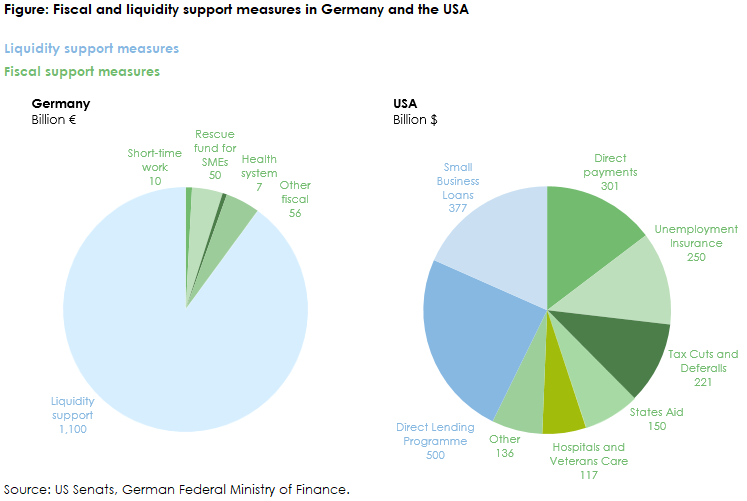
Economic Policy: International Responses to the Corona Crisis
In recent weeks, the global economy has suffered one of the biggest shocks of the post-war period. The current crisis is a combination of supply and demand shock. Supply chains have been disrupted and millions of people have lost their jobs temporarily. In addition, household consumption is shrinking and companies are revising their investment plans due to the high level of uncertainty. The decline in household and corporate spending may also result in losses in sectors not directly affected by government closures or a lack of supplies of inputs. The massive restriction of economic activity will also put pressure on sound companies if they run into liquidity problems due to lack of sales. This problem may get further exacerbated by the shrinking demand for goods and services.
The primary goal of economic policy during this period is to aim at a V-shaped economic recovery: after the current phase of a sharp economic downturn, the economy should recover as quickly as possible once the situation returns to normal. The economy should therefore be "frozen" as much as possible in order to limit the spread of the disease at the moment without causing too much economic damage for the future. The measures to achieve this can be divided into two categories: liquidity support for businesses in the form of loans, tax deferrals or tax reductions and non-repayable support payments on the one hand, and on the other hand – support for households currently suffering from loss of income and great uncertainty on. In addition, additional funds are planned for the health system, as well as direct support and assistance for specific, severely affected sectors is being discussed and implemented.
European countries act decisively but uncoordinated
European countries have recognised the economic dangers ahead and communicated rapidly or even already implemented they will do everything possible to protect their economies against the economic consequences of the coronavirus crisis, "whatever the cost". In Austria, the aid package currently amounts to 38 billion € (about 9.5 percent of GDP) and includes funds for short-time work (0.4 billion €), a help fund for one-person enterprises and SMEs, additional health care expenditure and support for companies through tax deferrals and tax reductions (10 billion €). In addition, an emergency fund of 15 billion € will be made available for particularly affected sectors and 9 billion € will be available for loan guarantees.
Germany announced a first package of economic measures of significant size on 13 March 2020 – a "bazooka" to cushion the effects of the coronavirus crisis. This included an unlimited credit programme for companies and an aid package for the cultural sector. This first package was then extended to a much larger rescue package for the paralysed German economy. The current final rescue package, which totals 1.2 trillion € (35 percent of GDP), was voted in the German Bundestag on 23 March 2020. It includes 122.5 billion € for additional state spending, including emergency aid for micro-enterprises and the self-employed (50 billion €), a relaxation of the conditions for short-time work benefits (10 billion €) and further funds for the health system. Tax deferrals of 33.5 billion € are also planned. An economic stabilisation fund for all enterprises will be set up to provide liquidity support for companies (of which 400 billion € will be guarantees to secure corporate liabilities, 100 billion € for direct temporary equity participations in companies and 100 billion € for borrowing to refinance KfW's corona-related special programmes). In addition, the guarantee framework for KfW will be extended to a maximum of 449 billion €.
In France, the measures announced so far amount to around 45 billion € (1.9 percent of GDP) and include a fund for small businesses, the deferral of corporate tax and social security contributions for employers and two months of government payments to sacked workers ("chomage partiel"). Committed liquidity measures currently amount to about 300 billion € (12.4 percent of GDP).
Spain has so far announced a fiscal package of 17 billion € (1.4 percent of GDP), with support for tenants, deferral of social security contributions for companies and labour market measures, but the details have yet to be finalised. In addition, 8 percent of GDP will be provided in the form of credit assistance and guarantees (100 billion €).
In Italy, the first measures amounted to 25 billion € (1.4 percent of GDP), including 10 billion € for support to workers and families and 3.5 billion € for the health system. The liquidity support promised so far is up to 350 billion € (19.6 percent of GDP). The scale of the crisis there will probably require further measures.
In the UK Finance Minister Rishi Sunak announced on 20th March 2020 a "Plan for People's Jobs and Incomes" with a pledge that the UK government will take over 80 percent of the wages and salaries of retained workers. Several other measures have also been promised (support for tenants, deferral of VAT, additional resources for the social system) to keep the economy running. In total, the liquidity package amounts to 350 billion £ (around 16 percent of GDP), with 20 billion £ of this amount going to tax cuts and non-repayable loans for SMEs and 330 billion £ to loan guarantees.
In Denmark, similar to Austria and Germany, the government has introduced a short-time work model where the government pays 75 percent of employees' salaries on condition that companies do not lay off workers; the total amount of expenditure required could reach up to 13 percent of GDP.
A number of EU countries have thus reacted very quickly and efficiently in recent weeks in order to limit the economic shock as far as possible. Austria has launched an ambitious aid package, also by international standards, to cushion the economic turbulence.
In the USA there has been a heated debate in recent weeks about an appropriate response. After several debates, the United States Senate finally agreed to a total package of over 2 trillion $ (approximately 1.85 trillion €). This includes an expansion of unemployment insurance system by 231 billion €, 324 billion € for loans to small businesses, and 462 billion € for other business loans, including for the suffering company Boeing, and tax deferrals for 204 billion €. A further 138 billion € is planned as aid for individual states, as well as 108 billion € for the health system, hospitals and veterans care. One of the most hotly debated issues was whether all citizens should receive direct payments or whether unemployment benefits, which are more targeted at specific groups, are a better suited instrument. Ultimately, 278 billion € in direct payments will be made to the population. Specifically, individuals with an annual salary of less than 75,000 $ will receive a cheque for 1,200 $, plus 500 $ for each child.
EU-wide and international response
Early action by a number of governments was rapid and promising. The International Monetary Fund announced that it would support the extraordinary fiscal measures that many countries have already taken to strengthen healthcare systems and protect workers and companies affected. At the EU level, the European Commission has agreed to take extraordinary fiscal measures and enacted the emergency clause of the Stability and Growth Pact so that the deficit rules will no longer be in force for this year. The rules on state aid have also been relaxed to allow for massive state support measures for companies. In addition, as part of a "Coronavirus Response Investment Initiative", 38 billion € of unused and as yet unallocated structural fund resources are to be diverted from the EU budget. Furthermore, by extending the scope of the European Solidarity Fund, up to 800 million € for 2020 can be distributed to member countries affected by the corona crisis. A further 179 million € can be used from the European Globalisation Fund to support the unemployed during the crisis. In this way, a total of up to 38 billion € has been made available.
The European Central Bank has announced a new Pandemic Emergency Purchase Programme (PEPP) for government bonds. This programme helped ease pressure on financial markets and ensured that governments and companies will be able to obtain credit under suitable financing conditions so that they can implement the stabilising measures now required. The measures have immediately dampened yields on government bonds in the euro area, thereby initially securing favourable financing conditions for companies as well.
However, there are concerns that the measures taken by national governments and central banks will not be sufficient to stimulate demand and sufficiently cushion the economic turbulence. An ongoing debate therefore evolved on how existing or new European institutions or instruments could further strengthen the fiscal stimulus so that the entire burden does not fall on national budgets. For example, further financing could be provided to individual countries through the European Stability Mechanism (ESM). However, ESM financing is linked to reform conditionalities, which is considered inappropriate to the current crisis. To this end, the discussion has also been revived as to whether the euro area should not have a joint debt instrument so that all countries can make the necessary expenditures under the most profitable conditions in the coming months. According to media reports, ECB President Christine Lagarde has discussed a one-off Coronabond issue as a possible option, and nine EU heads of state officially requested in an open letter on Wednesday, 25 March 2020, that the EU Council discuss this option. However, the chances of success seem rather limited at present.

























